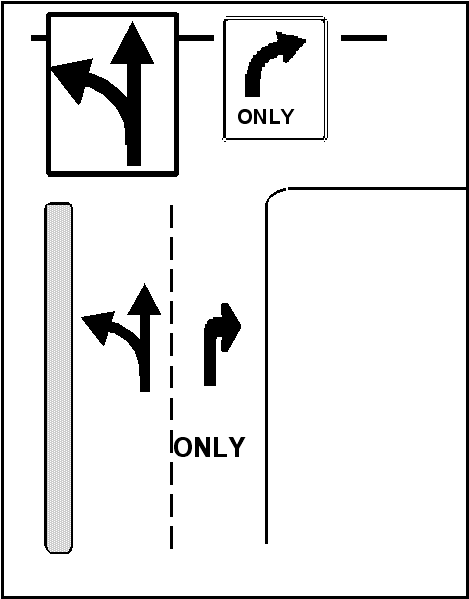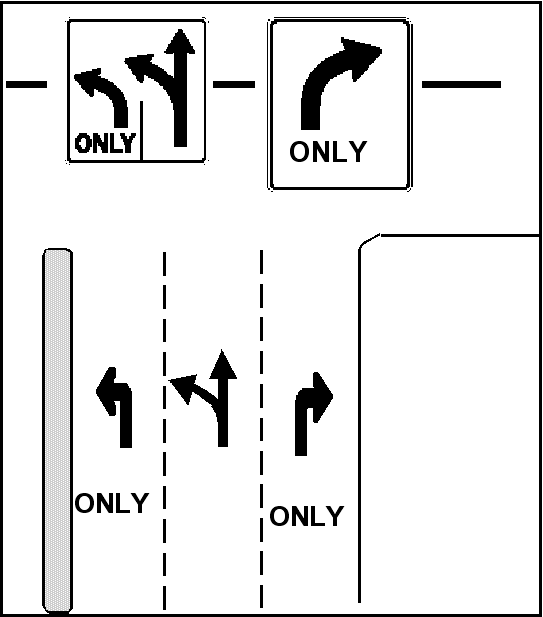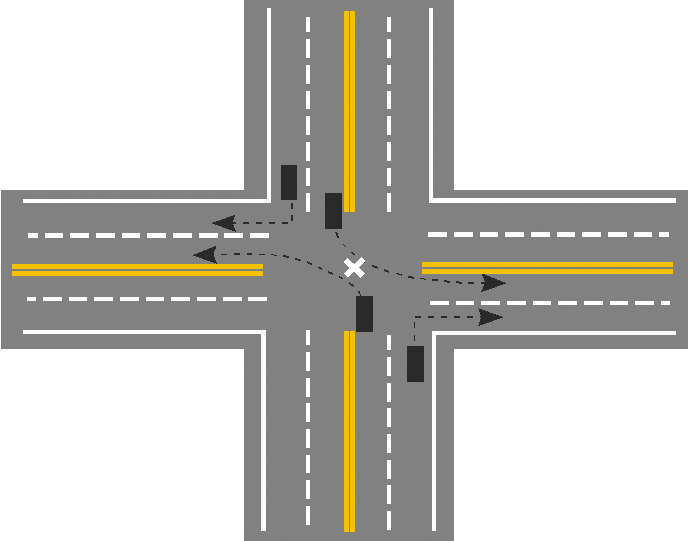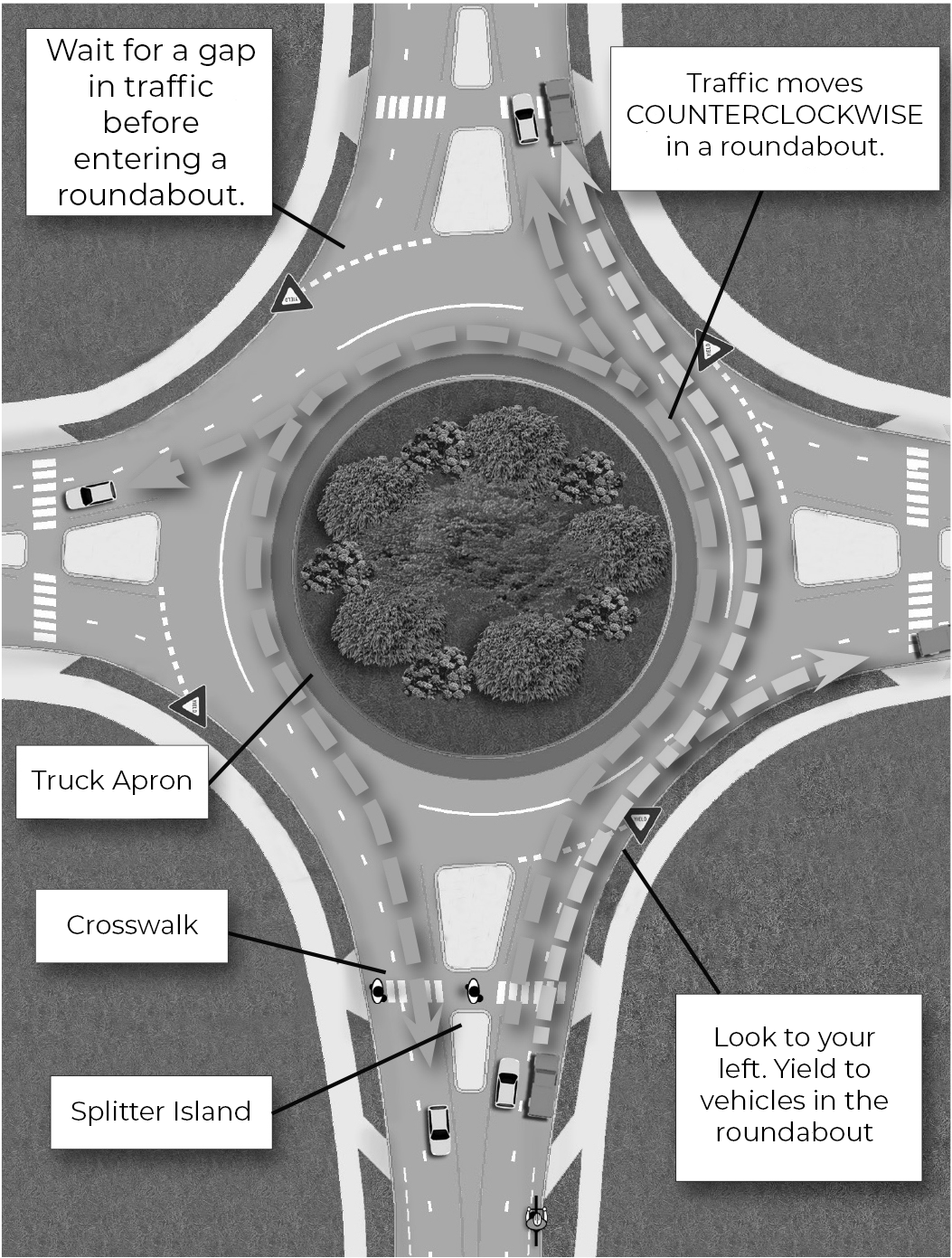At Three Way Intersections Drivers Turning Are to Yield to Drivers Continuing Straight
Negotiating Intersections
Teen Crash Fact
Intersections are places where teenage drivers have a high percentage of their crashes. In over one-third of the crashes involving 16-year-old drivers in Pennsylvania, the teen driver was pulling out from a stop sign or turning left across traffic.
The law does not give anyone the right-of-way at intersections; it only says who must yield. Even when one driver is legally required to yield right-of-way, if they fail to do so, other drivers are still required to stop or yield as necessary to avoid a crash. Never insist on having the right-of-way; it may result in a crash.
Laws governing who must yield in different driving situations are listed below. You must follow these laws if there are no signs, signals, or police present to tell you what to do at the intersection:
- Drivers must yield to pedestrians when they are: a) crossing at any intersection without a traffic light (with or without a crosswalk); b) crossing the roadway in marked crosswalks, whether or not at an intersection; c) walking on a sidewalk crossing a driveway or alley; and d) when the driver is turning a corner and pedestrians are crossing with the light. Drivers must always yield to any blind pedestrian carrying a white cane or being led by a guide dog.
- Drivers turning left must yield to oncoming vehicles going straight ahead.
- Drivers entering a circular intersection (or roundabout) must yield the right-of-way to drivers already in the circle.
- When two vehicles approach or enter an intersection from different roadways at or about the same time, drivers coming from the left must yield to vehicles coming from the right.
- A vehicle entering a public highway from an alley, private road, or driveway must wait until the main road is clear.
- At a four-way stop, all vehicles must stop. The first vehicle to reach the intersection should move forward first. If two vehicles reach the intersection at the same time, the driver on the left yields to the driver on the right. If facing one another both can proceed with caution, watching for possible turns.
Approaching Intersections
As you approach an intersection, look for signs, signals, and pavement markings telling you what movements are allowed from which lanes. Get into the correct position to turn or to travel through the intersection well in advance.
Signs And Pavement Markings For Lane Assignment

Many streets have signs or pavement markings indicating a particular lane is to be used for a particular traffic movement. If you end up in a lane marked for turns only when you want to go straight through the intersection, you must make the turn. If you want to turn but end up in a lane marked for through traffic, you must continue straight through the intersection. At the intersection shown on the right, the signs and markings tell you if you are in the right lane, you may only turn right, and if you are in the left lane, you may either turn left or go straight through the intersection.

The signs and markings in the diagram shown to the left, include dual left-turn lanes. You may turn left from either lane, but the driver next to you may turn left at the same time. Do not change lanes during the turn, as this will cause you to crash into the driver turning next to you. Also, watch out for the driver next to you straying into your turning path. The signs and markings here indicate you must turn right if you are in the right lane. If you are in the left lane, you must turn left. If you are in the center lane, you may either turn left or go straight through the intersection.
Traffic Signals and Stop Signs
Your safety at intersections depends a lot on your proper response to the green, yellow, and red lights you see on traffic signals and to two-way and four-way stop signs.
One Way, Wrong Way, And Do Not Enter Signs
Many streets in cities are one-way streets. You will know traffic on a particular street moves in only one direction if you see ONE WAY signs posted at the intersection. Another clue a road is one way is when you see vehicles parked on both sides of the road headed in the same direction.
You will see ONE WAY signs, WRONG WAY signs, and DO NOT ENTER signs all together at roads intersecting with divided highways. You can think of a divided highway as two, one-way streets. Most have a physical barrier separating traffic moving in each direction. This could be a narrow concrete barrier, or it could be a wide cement or grassy area. You will usually see a DIVIDED HIGHWAY sign on your road as you approach the intersection.
Making a right turn onto a divided highway is no different from making a right turn at any other intersection. Make sure you have a safe gap to turn right in front of traffic approaching from your left.
There is a special danger in making a left turn onto a divided highway, however. If you do not realize you are turning onto a divided highway, you may turn left before you get to the physical divider and end up in a head-on collision with traffic approaching from your left. You must take notice of the DO NOT ENTER and WRONG WAY signs.
To correctly turn left onto a divided highway, you need to cross the "first" roadway when there is a safe gap in traffic approaching from your left, and then turn left on the other side of the barrier, when there is a safe gap in traffic approaching from the right on the "second" roadway.
Moving Into And Through Intersections Safely
- To travel across an intersection with a two-way stop sign, you need about a six-second gap in both directions to cross a 30 mph street or about a block of clear space to the right and left. At the stop sign, first look to the left, then look to your right for a safe gap, and then quickly check to your left again before proceeding.
- To turn right, look left, straight ahead, right, and then left again to make sure there is no traffic coming. Allow a gap of about eight seconds between you and any vehicle approaching from the left.
- To turn left, make sure you have a clear gap to turn in front of oncoming traffic, and traffic on the cross street is stopped. If you are turning from a minor onto a major street, allow a nine-second gap between you and any vehicle approaching from the right.

It is important when turning left to avoid conflicts with vehicles turning left from the opposite direction. In the diagram at the right, imagine an "X" at the center of the intersection. By turning before you reach the "X," you avoid a "tangle turn" with the other left-turning driver. By always turning into the lane closest to the centerline, you also avoid interfering with traffic coming from the opposite direction making a right turn onto the same street.
Most important: Never start a left turn until you can see all the lanes you need to cross are clear, and you can safely make the turn.
Jughandles
Some roads in busy, commercial areas have a physical barrier dividing traffic moving in opposite directions and signs at the signalized intersections saying NO LEFT TURN or NO U-TURN and ALL TURNS FROM RIGHT LANE. In this situation, the road may be designed with jughandles for making left turns. Instead of making a left turn directly across oncoming traffic, you will use a right turn lane curving back to intersect the major road at a traffic light then turn left.
Circular Intersections

Roundabouts and traffic circles are circular intersections where traffic moves counter-clockwise, so that all turns into and out of the circle are right turns. This eliminates the risk of head-on, left-turn, and right-angle crashes. Roundabouts have special rules and a special design making them different from traffic circles, however.
We will focus on how to use roundabouts since these kinds of circular intersections are replacing the large, old-fashioned, and high-speed traffic circles or are being installed in many communities instead of intersections with traffic signals primarily due to their safety and operational benefits. Roundabouts are sometimes installed at the end of the ramp of interchanges.
Roundabouts have YIELD signs at each entry point and yield lines painted on the pavement at each entry point. Most roundabouts also have a destination sign on the approach so you know where each exiting road will take you.
Did You Know?
The most frequent cause of crashes at roundabouts is drivers who fail to yield before they enter.
How To Use A Circular Intersection
Approaching And Entering
- When approaching a roundabout SLOW DOWN and be prepared to yield to pedestrians in the crosswalk.
- Pull up to the Yield Line, look to the left, and check for approaching traffic within the roundabout, CIRCULATING TRAFFIC HAS THE RIGHT- OF-WAY.
- Enter the roundabout when there is an adequate gap in traffic.
Exiting The Roundabout
- Once you have entered the roundabout, proceed counterclockwise to your exit point. YOU now have the right-of-way.
- As you approach your exit, use your RIGHT TURN SIGNAL.
- Watch for pedestrians in the crosswalk and be prepared to yield.
- Exit the roundabout.
Be Prepared For
Emergency vehicles. Do not enter the roundabout when emergency vehicles are approaching. Pull to the side instead. If in the roundabout, immediately exit the roundabout and pull to the side. NEVER STOP IN THE ROUNDABOUT.
Bicyclists. Bicyclists have the option to function as a vehicle or pedestrian when using a roundabout. When acting as a vehicle, they will follow the same rules. NEVER OVERTAKE A BICYCLIST ACTING AS A VEHICLE IN A ROUNDABOUT.
Pedestrians. Motorists must yield to pedestrians when entering and exiting a roundabout. Pedestrians will use crosswalks and splitter islands to cross each leg of the roundabout.
Content Editor [3]
schardtaceeakell1955.blogspot.com
Source: https://www.dmv.pa.gov/Driver-Services/Driver-Licensing/Driver-Manual/Chapter-3/Everyday-Driving/Pages/Negotiating-Intersections.aspx
0 Response to "At Three Way Intersections Drivers Turning Are to Yield to Drivers Continuing Straight"
Post a Comment